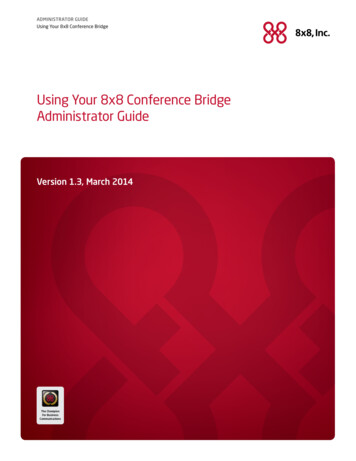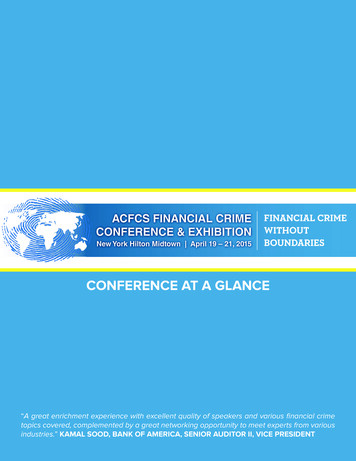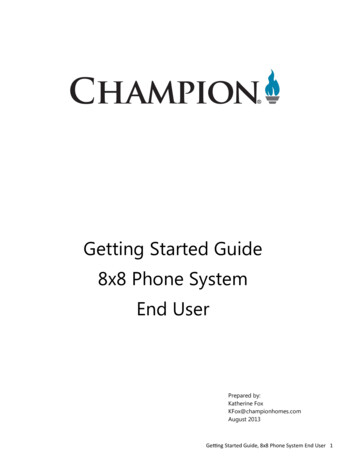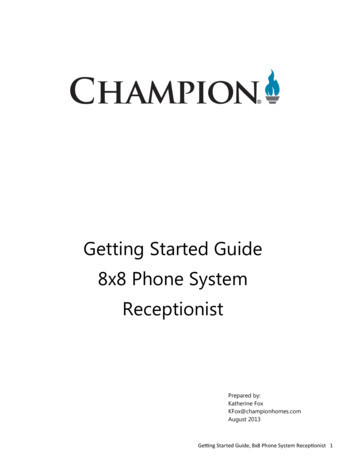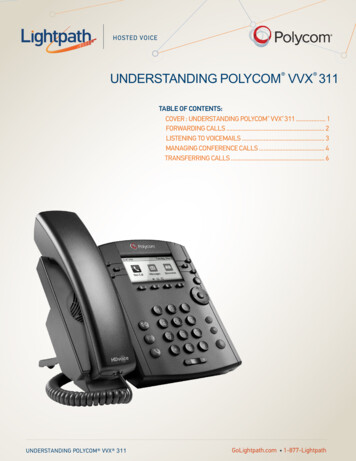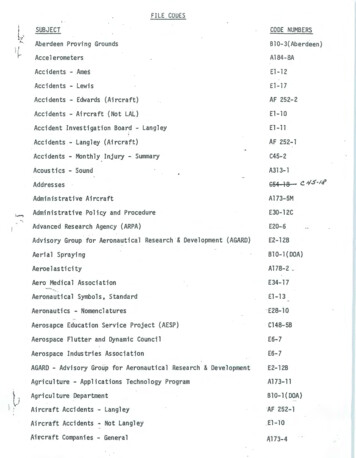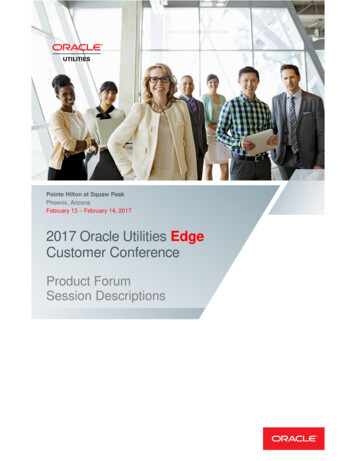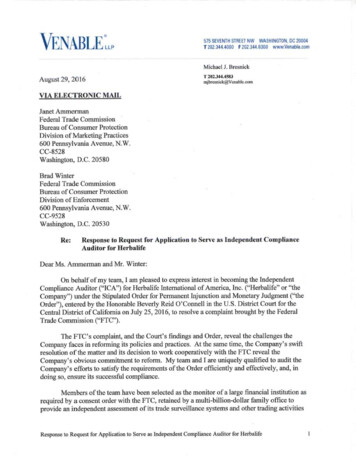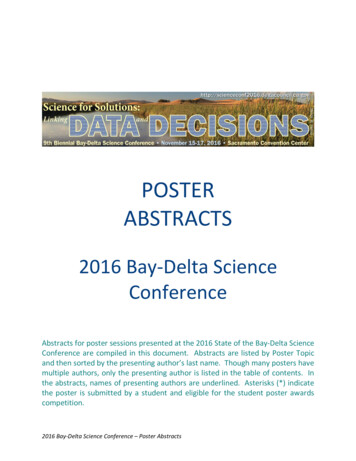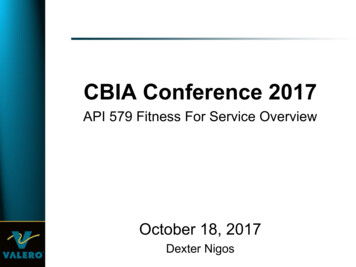
Transcription
CBIA Conference 2017API 579 Fitness For Service OverviewOctober 18, 2017Dexter Nigos
Agenda Fitness for Service Background Introduction Joint API/ASME FFS Standard (2000 edition)Jurisdictional RequirementsFitness For Service Overview Scope and Applications ProcedureExample Problems Section 4 – General Metal Loss Section 5 – Localize Metal Loss Section 6 – Pitting Corrosion Section 9 – Crack-Like Flaws Overview of 2007 FFS Edition Technical Basis and Validation of 2007 Edition API 579-1/ASME FFS-1 2016 Edition2
Fitness for Service Introduction ASME and API codes and standards provide guidelines for design,fabrication, inspection and testing. These codes do not provide guidelines for evaluating equipmentthat have been in service. ASME formed Post Construction Main Committee (PCC) in late1990s to develop standards for in-service fixed equipment API CRE Task Group continued to develop API 579, manycommittee members served on both committees.3
Fitness for Service Introduction The first edition of API 579 Fitness-For-Service (FFS) produced byAPI CRE FFS Task Group was issued in 2000 and became the defacto international Fitness-For-Service (FFS) Standard for pressurecontaining equipment in the refining and petrochemical industries In order to streamline development efforts, pool resources, andpromote widespread regulatory acceptance, API and ASME agreeto form a joint committee to produce a single FFS standard that canbe used for pressure-containing.4
Joint API/ASME FFS Standards Committee Joint API/ASME Committee formed, first meeting takes place onFebruary 5, 2002 Polices and procedures manual developed covering Charter Organization Officers Membership Meetings Committee Actions (Voting and Balloting) Public Review and Submittal to ANSI Interpretations Appeals Records Polices and procedures manual approved by API CRE and ASMEBPTCS5
Jurisdictional Requirement CCR Title 8, Chapter 4, Subchapter 15 Petroleum Safety Orders,Article 18 – Unfired Pressure Vessels, Boilers and Fired PressureVessels, §6857(c)(3): Program to include (summary): Acceptance by signature of the plant managementThe type of vessels coveredDocumentationInvolvement of Operations, Engineering, Inspection, and maintenanceProcedure for notifying the Division.6
Fitness for Service OverviewScope Supplement and augment requirements of APIEvaluation of both the present integrity of an equipment –given present state of damage – and projected remaininglife.Evaluate equipment constructed and designed to; ASME Section VIII D1/D2, Section I, B31.3 and B31.1 API 650 and 620 International and Internal Corporate standardsAssessment techniques include, but not limited to; Brittle fracture, local & general metal loss, crack-likeflaws, pitting, blistering, fire damage, etc.Provide in-service monitoring and NDE guidelinesDocumentation7
Fitness for Service OverviewApplication Equipment constructed and designed to; ASME Section VIII D1/D2, Section I, B31.3 and B31.1 API 650 and 620 International and Internal Corporate standardsDetermine if an equipment may be operated at the originalMaximum Allowable Working Pressure (MAWP).Determine the minimum required thicknessReduced temporary MAWP based on the founddamage/flaw.Evaluate equipment that is discovered to be lackingappropriate docsEvaluate equipment found to have not been designed orconstructed to original design criteria8
Fitness for Service OverviewProcedure Step 1 – Flaw or Damage Mechanism Identification9
Fitness for Service OverviewProcedure (cont.) Step 2 – Applicability and Limitations Step 3 – Data Requirements See Table 2.2 in API 579 for overview of data required Examples; Thickness profiles, pitting depth, dimensionsof crack-like flaws, etc. Extent of information and data required depends onlevel of assessment and damage mechanism beingvaluated. Step 4 – Assessment Techniques and Acceptance Criteria Level 1, 2 and 3 assessments10
Fitness for Service OverviewProcedure (cont.) Step 5 – Remaining Life Calculation Use to establish inspection plan, intervals and anyremediation Estimates with adequate safety factor Step 6 – Remediation Coating/lining to isolate the environment Drilling of blisters, monitoring, repair, etc. Changes to the process stream Step 7 – In-Service Monitoring Increase confidence in the remaining life assessment Step 8 – Documentation All calculations and documentation used to perform theanalysis.11
Example ProblemsExample #1 – General Metal Loss Result from corrosion, erosion or both. Based on thickness averaging approach.Applicability And Limitations Uniform or localCan calculate reduced MAWP if acceptance criteria are notsatisfiedSome limitations depending on level of assessment (level 1,2 or 3): No crack-like flaws . No notches i.e. local stress concentrations Not in creep regime Not in cyclic service12
Example ProblemsExample #1 – General Metal Loss (PART 4)13
Example ProblemsExample #1 – General Metal Loss (cont.) Follow assessment techniques and acceptance criteria in Part4 of API 579 (Level 1 Level 2 Level 3, as needed). Failed Level 1 assessment. Passed Level 2 assessment at a reduced MAWP. Alternatively, use industry recognized software (PlantManager, CodeCalc, etc) to complete the assessment.14
Example ProblemsExample #1 – General Metal Loss (cont.)15
Example ProblemsExample #1 – General Metal Loss (cont.)16
Fitness for Service OverviewExample #1 – General Metal Loss (cont.)17
Example ProblemsExample #1 – General Metal Loss (cont.)18
Example ProblemsExample #2 – Local Metal Loss (PART 5)19
Example ProblemsExample #2 – Local Metal Loss20
Example ProblemsExample #2 – Local Metal Loss (cont.) Passed Level 1 Assessment slightly reduced MAWP (OriginalDesign Pressure 300psig)21
Example ProblemsExample #3 – Pitting (PART 6)Applicability and Limitations Can be used to evaluate general and localized pitting. Can calculate reduced MAWP if acceptance criteria are notsatisfied For Level 1 and 2, some rules in PART 5 may apply. Level 2 assessment if pitting damage is on both sides. NOTE: Precise measurement of pitting is difficult.22
Example ProblemsExample #3 – Pitting (cont.)23
Example ProblemsExample #3 – Pitting (cont.)24
Example ProblemsExample #3 – Pitting (cont.) Follow Level 1 assessment per Part 6Perform Level 2 or 3 assessment as needed.25
Example ProblemsExample #3 – Pitting (cont.)26
Example ProblemsExample #3 – Pitting (cont.)27
Example ProblemsExample #3 – Pitting (cont.) 2007 Edition – Pitting Charts28
API 579-1/ASME FFS-1, 2007 EditionOverview Released on 2Q2007Includes new enhancements and new parts covering FFSassessment procedures that address unique damagemechanism: Part 5 - Assessment of Local Thin Areas Level 1 screening procedure modified Assessment procedures for gouges have been relocated toPart 12Part 7 - Assessment of Blisters and HIC/SOHIC Damage Assessment procedures for HIC/SOHIC damage have beenadded Assessment of lamination moved to Part 13Part 8 - Assessment of Weld Misalignment and Bulges Assessment procedures for bulges removed Assessment procedures for dents, gouges, and dent-gougecombinations have been relocated to Part 1229
API 579-1/ASME FFS-1, 2007 EditionOverview (cont.) Part 10 - Assessment of Equipment Operating in the CreepRange, Assessment procedures for remaining life calculations forcomponents with or without crack-like flaws have beenadded, New PartPart 12 - Assessment of Dents, Gouges, and Dent-GougeCombinations, New PartPart 13 - Assessment of Laminations, New Part New enhancements to existing annexes.New annexes API-1/ASME FFS-1 2007 Edition to supersede API 579-2000Edition.30
API 579-1/ASME FFS-1, 2007 EditionTechnical Basis and Validation Joint API/ASME FFS Committee committed to publishing thetechnical basis to all FFS assessment procedures utilized inAPI 579-1/ASME FFS-1 2007 in the public domain NBIC has supporting language for Fitness for Service in NB23 Part 2 Inspection. Appendix H of API 579-1/ASME FFS-1 2007 provides anoverview of technical basis and validation with relatedreferences organized by damage type; the references arepublished in a series of WRC Bulletins and technical papers Publication of technical background has been instrumental inobtaining acceptance from regulatory bodies31
API 579-1/ASME FFS-1, 2016 Edition32
API 579-1/ASME FFS-1, 2007 Edition. Technical Basis and Validation Joint API/ASME FFS Committee committed to publishing the technical basis to all FFS assessment procedures utilized in API 579-1/ASME FFS-1 2007 in the public domain NBIC has supporting lan

